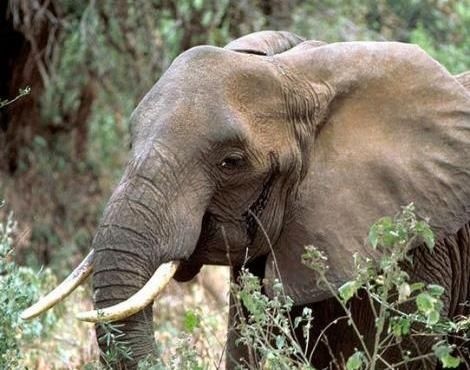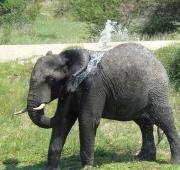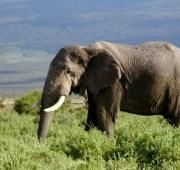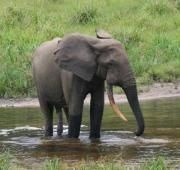
The African Forest Elephant is one of two Elephant subspecies found on the African continent. Although the African Forest Elephant is slightly smaller than the African Bush Elephant, it is still one of the largest animals found on land today. Although these two Elephant species are very similar, the African Forest Elephant is thought to have rounder ears and straighter tusks than the African Bush Elephant, and it has been also noted that the African Bush Elephant and the African Forest Elephant have a different number of toe nails. Until recently though, they were considered to be the same species.
The African Forest Elephant is the one of the largest known land mammals on Earth, with male African Forest Elephants reaching nearly 3 metres in height and the female African Forest Elephants around 2.5 metres. The tusks of an African Forest Elephant can grow to nearly 1.5 meters long and generally weigh between 50 and 100 pounds, which is about the same as a small adult Human. They are thinner, straighter and shorter than the tusks of the African Bush Elephant. African Forest Elephants have four molar teeth each weighing about 5.0 kg and measuring about 12 inches long. They have large rounded ears which are used both for hearing and to keep them cool.




| Kingdom: | Animalia |
| Phylum: | Chordata |
| Class: | Mammalia |
| Order: | Proboscidea |
| Family: | Elephantidae |
| Genus: | Loxodonta |
| Scientific Name: | Loxodonta cyclotis |
| Common Name: | African Forest Elephant |
| Other Name(s): | African Elephant |
| Group: | Mammal |
| Number Of Species: | 1 |
| Location: | central and southern Africa |
| Habitat: | Forest, savannah and flood plains |
| Colour: | Grey, Brown |
| Skin Type: | Leather |
| Size (H): | 2m - 3m (6.6ft - 9.8ft) |
| Weight: | 900kg - 3,000kg (1,984lbs - 6,613lbs) |
| Top Speed: | 39km/h (24mph) |
| Diet: | Herbivore |
| Prey: | Grass, Fruit, Roots |
| Predators: | Human, Lion, Hyena |
| Lifestyle: | Diurnal |
| Group Behaviour: | Herd |
| Life Span: | 60 - 70 years |
| Age Of Sexual Maturity: | 11 - 20 years |
| Gestation Period: | 22 - 24 months |
| Average Litter Size: | 1 |
| Name Of Young: | Calf |
| Age Of Weaning: | 5 years |
| Conservation Status: | Endangered |
| Estimated Population Size: | 200,000 |
| Biggest Threat: | Poaching and habitat loss |



